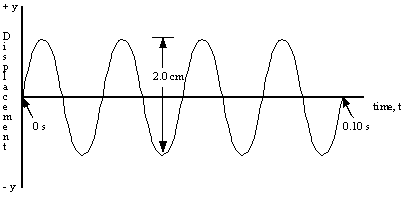
16.2. Periodic Waves
Three quantities are needed to describe periodic waves: period, wavelength, and amplitude. The wavelength and amplitude can be found from a space representation of the wave which is essentially a "snapshot" taken of the wave at an instant in time.
The period and amplitude can be found from a time representation of the wave. This is constructed by making a graph of the motion of a point in the medium. The graph is the displacement of the point from its undisturbed position versus time. This is equivalent to making a vertical position versus time graph of a small cork bobbing up and down in water as a wave passes by.
Example 1A snapshot is taken of a periodic wave traveling on a string as shown below. What is the amplitude and wavelength of the wave?
 |
A point in the medium carrying the wave in example 1 is observed and a displacement versus time graph is made and shown below. Find the period, frequency, and amplitude of the wave from this graph. What is the speed of the wave?
 |
Radio waves travel with a speed of